Wednesday, August 03, 2005
La Mesa RV Park, Cortez, CO - July 28-Aug 3
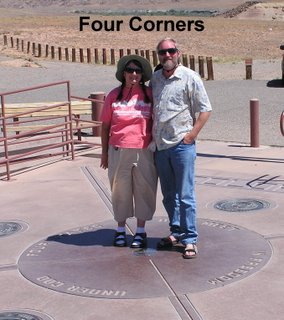 Still traveling with Pat & Dennis, we picked out several areas to concentrate on in SW Colorado. We stayed in Cortez for a week because of the many local attractions that we either hadn't seen or wanted to revisit. We didn't know what to expect from Cortez, but we all had fairly negative expectations; however, the RV park was quite nice, with lots of shade and a view of open fields behind it, not at all like being right in a city. In addition, Cortez itself was quite charming, with many community activities.
Still traveling with Pat & Dennis, we picked out several areas to concentrate on in SW Colorado. We stayed in Cortez for a week because of the many local attractions that we either hadn't seen or wanted to revisit. We didn't know what to expect from Cortez, but we all had fairly negative expectations; however, the RV park was quite nice, with lots of shade and a view of open fields behind it, not at all like being right in a city. In addition, Cortez itself was quite charming, with many community activities.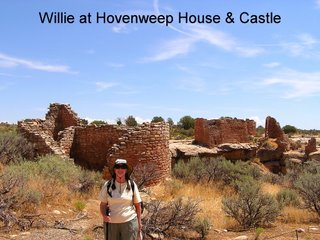 For a short day trip, we visited Four Corners Monument, located about 35 miles southwest of Cortez on tribal land, and the only place in the US where four states (CO, UT, NM, AZ) meet. In addition to the marker where everyone lines up for photos, local Utes, Hopis and Navajos sell their wares & food in shops at the site. It was especially interesting to see how much traffic stopped by in the short time we were there. We spent another day visiting Hovenweep Natl Mon, located on the border of Utah & Colorado about 45 miles from Cortez. Hovenweep includes 5 prehistoric Puebloan-era villages, each located at the head of a separate canyon within 16 miles of each other.
For a short day trip, we visited Four Corners Monument, located about 35 miles southwest of Cortez on tribal land, and the only place in the US where four states (CO, UT, NM, AZ) meet. In addition to the marker where everyone lines up for photos, local Utes, Hopis and Navajos sell their wares & food in shops at the site. It was especially interesting to see how much traffic stopped by in the short time we were there. We spent another day visiting Hovenweep Natl Mon, located on the border of Utah & Colorado about 45 miles from Cortez. Hovenweep includes 5 prehistoric Puebloan-era villages, each located at the head of a separate canyon within 16 miles of each other.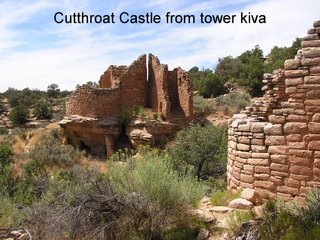 The Square Tower Unit is the primary facility with a visitor center, campground and the houses of Little Ruin Canyon. One of the most outstanding features at Hovenweep is the many towers. The earlier ones were round or square but as time went on they became more elaborate. There are many theories offered to explain the purpose of the towers. Some even think that there are more theories than towers! The two-mile loop walk at Little Canyon takes you past many structures, including Hovenweep Castle, Square Tower, Round Tower, Boulder House and Twin Towers.
The Square Tower Unit is the primary facility with a visitor center, campground and the houses of Little Ruin Canyon. One of the most outstanding features at Hovenweep is the many towers. The earlier ones were round or square but as time went on they became more elaborate. There are many theories offered to explain the purpose of the towers. Some even think that there are more theories than towers! The two-mile loop walk at Little Canyon takes you past many structures, including Hovenweep Castle, Square Tower, Round Tower, Boulder House and Twin Towers. We then took the unpaved road to Cutthroat Castle, one of the outlying units, about 8 miles northeast of the visitor center. From the parking area, it was just a bit over a mile to the lovely ruins, also located beside a small canyon. Near the beginning of the trail, we were able to overlook another tower, Painted Hand Pueblo, located on BLM land in Canyon of the Ancients NM. The small tower was all we could see from above, and we were too tired after our previous hikes in 90+ temps to hike further. Back near the paved highway to Cortez (US491), we visited Lowry Pueblo, also managed by the BLM in Canyon of the Ancients NM. Lowry Pueblo is a fairly large structure constructed around 1060 and inhabited for about 165 years. When the last families left to migrate further south, the pueblo consisted of 40 rooms, eight kivas and a Great Kiva.
We then took the unpaved road to Cutthroat Castle, one of the outlying units, about 8 miles northeast of the visitor center. From the parking area, it was just a bit over a mile to the lovely ruins, also located beside a small canyon. Near the beginning of the trail, we were able to overlook another tower, Painted Hand Pueblo, located on BLM land in Canyon of the Ancients NM. The small tower was all we could see from above, and we were too tired after our previous hikes in 90+ temps to hike further. Back near the paved highway to Cortez (US491), we visited Lowry Pueblo, also managed by the BLM in Canyon of the Ancients NM. Lowry Pueblo is a fairly large structure constructed around 1060 and inhabited for about 165 years. When the last families left to migrate further south, the pueblo consisted of 40 rooms, eight kivas and a Great Kiva.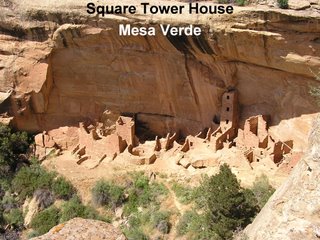 Next on our agenda was a day at Mesa Verde, which included stops at many overlooks, a drive on Chapin Mesa, Far View Community, and hikes to Spruce Tree House and back via Spruce Canyon Trail. This was much too little time to do the place justice, but it was great seeing the lovely structures again.
Next on our agenda was a day at Mesa Verde, which included stops at many overlooks, a drive on Chapin Mesa, Far View Community, and hikes to Spruce Tree House and back via Spruce Canyon Trail. This was much too little time to do the place justice, but it was great seeing the lovely structures again.
August 2, Willie's birthday, we relaxed and did household chores. Pat & Dennis made us a delicious dinner, complete with gifts & surprises. In the evening we went to an outdoor drama in the park, "Black Shawl". Writer, performer & storyteller Sharon French tells of her Native American
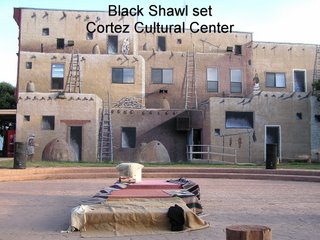 ancestry through the relationship between the elderly and wise Navajo woman, Black Shawl, and her granddaughter, Sarah Mara-Boots, a half Navajo and half Paiute girl raised by white settlers after her parents are killed. This was a wonderful presentation, and the story was totally amazing. If it wasn't a true story, it would not have been believable.
ancestry through the relationship between the elderly and wise Navajo woman, Black Shawl, and her granddaughter, Sarah Mara-Boots, a half Navajo and half Paiute girl raised by white settlers after her parents are killed. This was a wonderful presentation, and the story was totally amazing. If it wasn't a true story, it would not have been believable.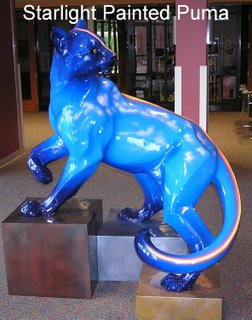 On our final outing, we visited McPhee Reservoir and the town of Dolores. At the visitor center in Cortez, we found our first "Puma on Parade", a collection of painted pumas in the southwest Colorado area. Unfortunately, several were located in Pagosa Springs, and we hadn't known to look there. We did find the two located in Cortez. In Dolores we found two more, one in a very lovely new library. We had hoped to visit the Anasazi Heritage Center, also in Dolores and with a painted puma in its lobby; however, when we got there, we found the visitor center closed due to roofing work. We could only tour the two outside excavated sites. McPhee Reservoir is a large body of water that unfortunately flooded over more than a thousand unexcavated sites. As a "reward" for allowing this, the COE gave the land for the Heritage Center and created several campgrounds in areas along the shore. In our opinion, this was not enough price to pay for so much destruction. The main campground does look like a nice place to stay in the future.
On our final outing, we visited McPhee Reservoir and the town of Dolores. At the visitor center in Cortez, we found our first "Puma on Parade", a collection of painted pumas in the southwest Colorado area. Unfortunately, several were located in Pagosa Springs, and we hadn't known to look there. We did find the two located in Cortez. In Dolores we found two more, one in a very lovely new library. We had hoped to visit the Anasazi Heritage Center, also in Dolores and with a painted puma in its lobby; however, when we got there, we found the visitor center closed due to roofing work. We could only tour the two outside excavated sites. McPhee Reservoir is a large body of water that unfortunately flooded over more than a thousand unexcavated sites. As a "reward" for allowing this, the COE gave the land for the Heritage Center and created several campgrounds in areas along the shore. In our opinion, this was not enough price to pay for so much destruction. The main campground does look like a nice place to stay in the future.